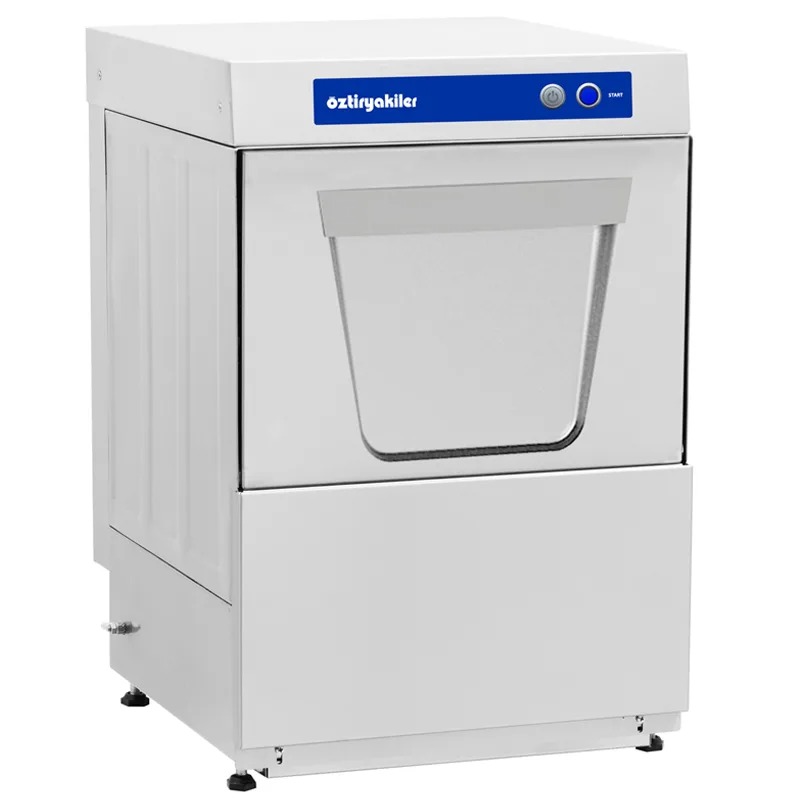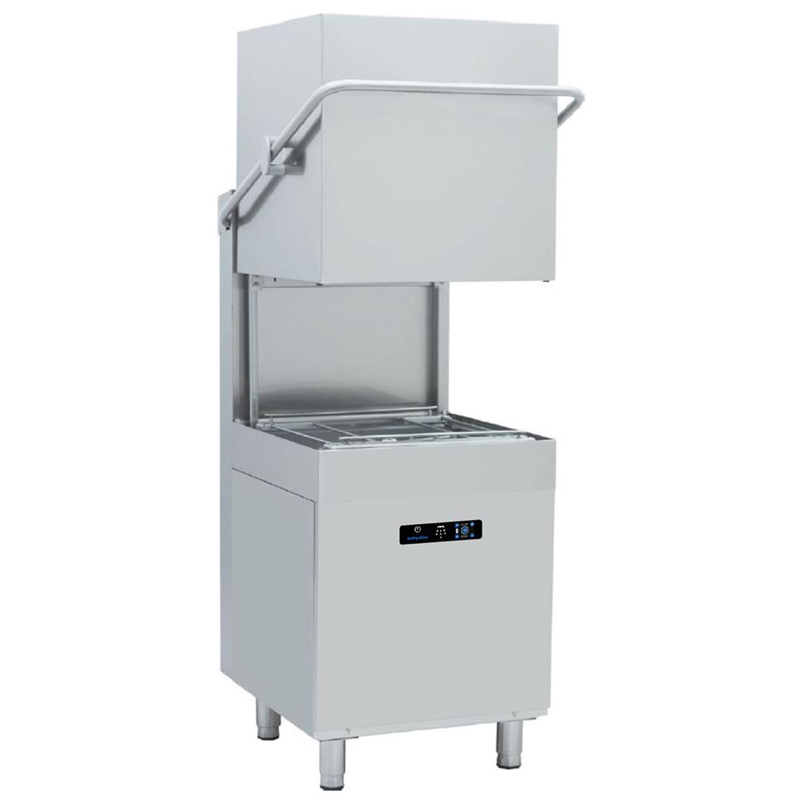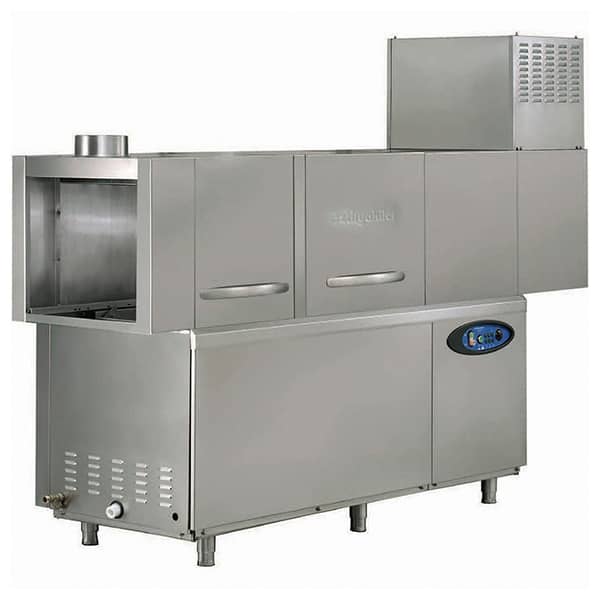In industrial kitchens, industrial dishwasher solutions are critically important for speed, hygiene, and low operating costs. Industrial-type dishwasher groups clean voluminous equipment such as glasses, plates, trays, and even pots in a short time. Professional dishwasher options increase service speed in hotels, restaurants, cafes, cafeterias, hospitals, and production facilities, and reduce water/energy consumption. Your dishes are washed in minutes with short washing programs.
Thanks to their compact structure, they save space in small and medium-sized kitchens. They provide high hygiene with fast programs ranging from 40 seconds to 3 minutes. They generally operate on 220–240 V single-phase. This is the most preferred professional dishwasher segment in cafes, restaurants, and hotels.


Meets the "cafe-type dishwasher" need for bars, cafes, and restaurants. It offers a shiny, streak-free clean on glass surfaces with programs of 90–180 seconds. Can be used on-counter or under-counter; stands out with low water/energy consumption. You can wash not only glasses but also plates and trays that fit inside the machine. Since they have the same technical specifications as under-counter dishwashers, prefer under-counter machines if you have the space.
Fast loading/unloading is possible thanks to the upward-opening door (hood). With programs ranging from 40–180 seconds, a capacity of approximately 1000 plates per hour, and 80–90 °C rinse, it is ideal for busy service hours. It is the right solution for professional kitchens needing a large dishwasher.


This is the highest capacity industrial-type dishwasher group. Dishes pass through washing–rinsing–drying stations on an automatic conveyor line. It provides continuous flow and minimal personnel requirement for hotels, hospitals, cafeterias, and factories.
Cleans large equipment such as pots, pans, trays, and cauldrons with 85–90 °C water and high spray pressure. Suitable for large production kitchens and catering businesses.

Dishwasher prices vary according to capacity (basket/chamber size), number of pumps (wash, rinse, drain, detergent, rinse aid), body material, energy type (single-phase/three-phase), technologies like heat recovery, and brand/service network. A model that suits the capacity and is energy-efficient lowers the total cost of ownership and shortens the return on investment period.
Are you looking for the most efficient dishwasher models for professional kitchens? Öztiryakiler dishwashers are specially designed for different capacities and usage areas! 🚀
Industrial dishwashers are one of the essential pieces of equipment for large kitchens and restaurants. So, how is an Öztiryakiler dishwasher used? What should you pay attention to during use? In this video, we share all the details you need to know to use your dishwasher efficiently!
Industrial dishwashers are the biggest helpers for businesses. However, if regular descaling is not performed, its performance drops, energy consumption increases, and the machine's life shortens. In this video, we explain in detail how to descale an industrial dishwasher, how often it should be done, and what to pay attention to in daily maintenance.
Prominent brands in the sector include Öztiryakiler, Empero, Hobart, Zanussi, Electrolux, Classeq, İnoksan, and Cancan. These brands offer alternatives suitable for businesses of different scales with their durability, service network, energy efficiency, and hygiene performance.
Question: How long does a dishwasher take to wash?
Answer: It varies from 40 seconds to 3 minutes depending on the model. Short programs increase service speed during busy hours.
Question: Which model is right for my business?
Answer: Glasswasher and under-counter for cafes/bars; under-counter or hood-type for restaurants; hood-type or conveyor for hotels/cafeterias/hospitals; conveyor and pot-washing for production kitchens are recommended.
Question: Can it be used at home?
Answer: Industrial machines require high power/water pressure; they are not suitable for residential plumbing. Only some compact glasswashers might be considered for small offices.
Question: What should the rinse temperature be?
Answer: Generally, a range of 80–90 °C is recommended; this is a critical value for hygiene and spotless results.
Question: How much water/energy does it consume?
Answer: Consumption varies by model and program. Glasswasher/under-counter machines use a low amount of water per wash; in conveyor systems, heat/water recovery reduces consumption.
Question: Which detergent/rinse aid should I use?
Answer: Industrial dishwasher chemicals must be used. Household products can cause excessive foaming and equipment malfunctions.
Question: Is a ventilation hood necessary?
Answer: Steam output is high in hood-type and especially conveyor machines; a ventilation hood/extraction system is recommended.
Question: Can we skip using rinse aid?
Answer: Rinse aid ensures that water and detergent sheet off surfaces like plates and glasses without leaving spots during the rinse phase. If rinse aid is not used, dullness or spots may occur on glass surfaces. The machine will run without rinse aid, but a professional level of hygiene and shine will not be achieved. Furthermore, for hygiene standards, especially in food businesses, the use of rinse aid is mandatory.
Question: Can rinse aid be poured in manually?
Answer: In industrial-type dishwashers, rinse aid cannot be poured in manually. The rinse aid must be fed automatically into the machine's rinse line. This process is done via a rinse aid pump. Manual pouring can lead to both an inability to set the correct ratio and a risk of damaging the machine.
Question: Can detergent be poured in manually?
Answer: In professional dishwashers, the wash time is very short; therefore, adding detergent manually for every wash is not practical or sustainable. Also, since these machines operate at high temperatures, direct contact with detergent is risky for user health. Although a detergent pump is not mandatory, it is indispensable for work safety and efficiency. However, in case of a pump malfunction or an emergency, detergent can be added manually as a temporary solution. In this case, adding about a tea glass of industrial dishwasher detergent every 10 washes is sufficient.
An investment in an industrial dishwasher increases service speed, raises hygiene standards, and lowers total costs when the correct capacity and technology are chosen. You can build an efficient and sustainable washing line by selecting the most suitable option among under-counter, glasswasher, hood-type, conveyor, or pot-washing machines based on your business's space, daily circulation, and infrastructure.